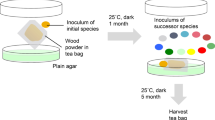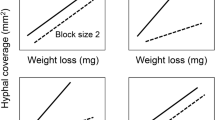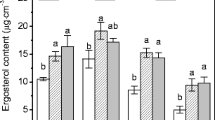Abstract
The effects of exudates from uncolonized and from partly decayed beech wood on the extension rates of 16 later stage decay fungi were investigated. The partly decayed wood had been colonized by the pyrenomycete Eutypa spinosa, or the basidiomycetes Fomes fomentarius, Stereum hirsutum, and Trametes versicolor, all known as common early decay agents in European beech forests. Sterilized wood pieces were placed onto 0.5% malt agar, opposite to small agar plugs containing the test fungi. The latter showed very variable and species-specific growth responses to the various wood types. The presence of uncolonized wood stimulated extension rates in many species, whereas the four previously decayed wood types had variable stimulatory or inhibitory effects. Wood decayed by S. hirsutum resulted in reduced extension rate, delayed growth, or total inhibition in the majority of species, thus it is suggested that this species uses secondary metabolites in a defensive strategy. A single species was, however, stimulated in the presence of S. hirsutum-decayed wood. In contrast, the presence of wood decayed by F. fomentarius was stimulatory to 45% of the species. The other previously decayed wood types generally resulted in more variable responses, depending upon species. The results are discussed in an ecological context and it is suggested that the exudates from the partly decayed wood that are responsible for the reported effects may function as infochemicals, structuring microbial communities in wood.





Similar content being viewed by others
References
SR Belmain MSJ Simmonds WM Blaney (2002) ArticleTitleInfluence of odor from wood-decaying fungi on host selection behavior of Deadwatch beetle, Xenostobium rufovillosum J Chem Ecol 28 741–754
M Binder D Hibbett (2002) ArticleTitleHigher-level phylogenetic relationships of homobasidiomycetes (mushroom-forming fungi) inferred from four rDNA regions Mol Phylo Evol 22 76–90
L Boddy (2000) ArticleTitleInterspecific combative interactions between wood-decaying basidiomycetes FEMS Microbiol Ecol 31 185–194
L Boddy (2001) ArticleTitleFungal community ecology and wood decomposition processes in angiosperms: from standing tree to complete decay of coarse woody debris Ecol Bull 49 43–56
L Boddy EM Owens IH Chapela (1989) ArticleTitleSmall scale variation in decay rate within logs one year after felling: effects of fungal community structure and moisture content FEMS Microbiol Ecol 62 173–184
A Bruce RE Wheatley SN Humphris CA Hackett M Florence (2000) ArticleTitleProduction of volatile organic compounds by Trichoderma spp. in media containing different amino acids and their effect on selected wood decay fungi Holzforschung 54 481–486
IH Chapela L Boddy ADM Rayner (1988) ArticleTitleStructure and development of fungal communities in beech logs four and a half year after felling FEMS Microbiol Ecol 53 59–70
IH Chapela O Petrini L Hagmann (1991) ArticleTitleMonolignol glucosides as specific recognition messengers in fungus-plant symbioses Physiol Mol Plant Pathol 39 289–298
D Coates ADM Rayner (1985) ArticleTitleFungal population and community development in cut beech logs, III: spatial dynamics, interactions and strategies New Phytol 101 183–198
OE Eriksson H-O Baral RS Currah K Hansen CP Kurtzman G Rambold T Læssøe (2003) ArticleTitleOutline of Ascomycota—2003 Myconet 9 1–89
J Fäldt M Jonsell G Nordlander A-K Borg-Karlson (1999) ArticleTitleVolatiles of bracket fungi Fomitopsis pinicola and Fomes fomentarius and their functions as insect attractants J Chem Ecol 25 567–590
SC Fryar TK Yuen KD Hyde (2001) ArticleTitleThe influence of competition between tropical fungi on wood colonization in streams Microb Ecol 41 245–251
JB Gloer (1995) ArticleTitleThe chemistry of fungal antagonism and defense Can J Bot 73 IssueID(Suppl. 1): 1265–1274
GS Griffith ADM Rayner HG Wildman (1994) ArticleTitleInterspecific interactions, mycelial morphogenesis and extracellular metabolite production in Phlebia radiata (Aphyllophorales) Nov Hed 59 331–344
R Guevera ADM Rayner SE Reynolds (2000) ArticleTitleOrientation of specialist and generalist fungivorous ciid beetles to host and non-host odours Physiol Entomol 25 288–295
L Hansen H Knudsen (Eds) (1992) Nordic Macromycetes, vol 2, Polyporales, Boletales, Agaricales, Russulales Nordsvamp Copenhagen
L Hansen H Knudsen (Eds) (1997) Nordic Macromycetes, vol 3, Heterobasidioid, Aphyllophoroid and Gastromycetoid Basidiomycetes Nordsvamp Copenhagen
L Hansen H Knudsen (Eds) (2000) Nordic macromycetes, vol. 1, Ascomycetes Nordsvamp Copenhagen
J Heilmann-Clausen (2001) ArticleTitleA gradient analysis of communities of macrofungi and slime moulds on decaying beech logs Mycol Res 105 575–596
J Heilmann-Clausen M Christensen (2003) ArticleTitleFungal diversity on decaying beech logs—implications for sustainable forestry Biodivers Conserv 12 953–973
SJ Hendry D Lonsdale L Boddy (1998) ArticleTitleStrip-cankering of beech (Fagus sylvatica): pathology and distribution of symptomatic trees New Phytol 140 549–565
Henningsson, B (1965) Physiology and decay activity of the birch conk fungus Piptoporus betulinus (Bull) Fr. Stud For Suecica: 34
L Holmer P Renvall J Stenlid (1997) ArticleTitleSelective replacement between species of wood-rotting basidiomycetes, a laboratory study Mycol Res 101 714–720
SN Humphris RE Wheatley A Bruce (2001) ArticleTitleThe effects of specific volatile compounds produced by Trichoderma spp. on the growth of wood decay basidiomycetes Holzforschung 55 233–237
SN Humphris A Bruce E Buultjens RE Wheatley (2002) ArticleTitleThe effects of volatile microbial secondary metabolites on protein synthesis in Serpula lacrymans FEMS Microb Lett 210 215–219
RC Littell GA Milliken WW Stroup R Wolfiner (1996) SAS System for Mixed Models SAS Publishing Cary, NC
AE Mackie RE Wheatley (1999) ArticleTitleEffects and incidence of volatile organic compound interactions between soil bacteria and fungal isolates Soil Biol Biochem 31 375–385
RG Miller (1981) Simultaneous Statistical Inference EditionNumber2 Springer New York
T Niemelä P Renvall R Pentillä (1995) ArticleTitleInteractions of fungi at late stages of wood decomposition Ann Bot Fenn 32 141–152
S Peters S Draeger H.-J Aust B Schulz (1998) ArticleTitleInteractions in dual cultures of endophytic fungi with host and nonhost plant calli Mycologia 90 360–367
ADM Rayner L Boddy (1988) Fungal Decomposition of Wood; Its Biology and Ecology John Wiley & Sons Chichester
P Renvall (1995) ArticleTitleCommunity structure and dynamics of wood-rotting Basidiomycetes on decomposing conifer trunks in northern Finland Karstenia 35 1–51
SAS (1999–2000) SAS for Windows, Version 8.01. SAS Institute Inc
AJ Score JW Palfreyman N White (1997) ArticleTitleExtracellular phenoloxidase and peroxidase enzyme production during interspecific fungal interactions Int Biodet Biodeg 39 225–233
CA Shearer (1995) ArticleTitleFungal competition Can J Bot 73 IssueID(Suppl. 1): 1259–1264
Shearer CA, Bartolata M (1990) Competitive interactions among aquatic lignicolous fungi. Fourth International Mycological Congress, Regensburg, Germany (abstract)
J Sonnenbichler J Dietrich H Peipp (1994) ArticleTitleSecondary fungal metabolites and their biological activities, V. Investigations concerning the induction of the biosynthesis of toxic secondary metabolites in basidiomycetes Biol Chem Hoppe-Seyler 375 71–79
DB Strongman JD Miller L Calhoun JA Findlay NJ Whitney (1987) ArticleTitleThe biochemical basis for interference competition among some lignicolous marine fungi Bot Mar 30 21–26
Thomsen, IM, Skov, S, Grønning, J, Lind, D (2001) Fomes fomentarius in natural and managed beech forests in Denmark. Forest and Landscape
JM Wells MJ Harris L Boddy (1998) ArticleTitleEncounter with new resources causes polarized growth of the cord-forming basidiomycete Phanerochaete velutina on soil Microb Ecol 36 372–382
RE Wheatley (2002) ArticleTitleThe consequence of volatile organic compound mediated bacterial and fungal interactions Ant van Leeuwen 81 357–364
RE Wheatley C Hackett A Bruce A Kundzewicz (1997) ArticleTitleEffect of substrate composition on production of volatile organic compounds from Trichoderma spp. inhibitory to wood decay fungi Int Biodet Biodeg 39 199–205
J Willig GB Schlegte (1995) ArticleTitlePilzsukzession an Holz nach Windwurf in einem Buckennaturwaldreservat Allgemeine. Forsch 15/1995 814–818
J Worral SE Anagnost RA Zabel (1997) ArticleTitleComparison of wood decay among diverse lignicolous fungi Mycologia 89 199–219
Acknowledgments
We thank Mikako Sasa and Novozymes for providing materials and equipment for isolating the wood inhabiting fungi used in the experiments and the Strødam committee for the permission to collect wood for the experiments. Further, Iben Magrethe Thomsen is thanked for useful comments on an earlier draft of the manuscript. Thanks to Paul Wald for discussion during experimentation. The research was supported by the Danish Research Councils.
Author information
Authors and Affiliations
Corresponding author
Rights and permissions
About this article
Cite this article
Heilmann-Clausen, J., Boddy, L. Inhibition and Stimulation Effects in Communities of Wood Decay Fungi: Exudates from Colonized Wood Influence Growth by Other Species. Microb Ecol 49, 399–406 (2005). https://doi.org/10.1007/s00248-004-0240-2
Received:
Accepted:
Published:
Issue Date:
DOI: https://doi.org/10.1007/s00248-004-0240-2




